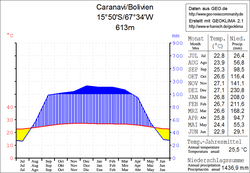Caranavi
| Caranavi | ||
|---|---|---|
 Caranavi Plaza |
||
| Basic data | ||
| Residents (state) | 13,569 pop. (2012 census) | |
| rank | Rank 43 | |
| height | 613 m | |
| Post Code | 02-2001-0100-1001 | |
| Telephone code | (+591) | |
| Coordinates | ||
|
|
||
| politics | ||
| Department | La Paz | |
| province | Caranavi Province | |
| climate | ||
 Caranavi climate diagram |
||
Caranavi is a small town in the La Paz department in the South American Andean state of Bolivia .
Location in the vicinity
Caranavi is the central place of the canton Caranavi in the district ( Bolivian : Municipio ) Caranavi and the seat of the administration of the province of Caranavi of the same name . The city is located in the Bolivian Yungas at an altitude of 613 m at the mouth of the Río Yara in the Río Coroico , on the eastern slope of the Cordillera Real , which rises in several peaks to over 6,000 m west of Caranavi.
geography
Caranavi lies in the transition area between the Andean Altiplano and the Bolivian lowlands. The climate is a typical time of day climate in which the mean temperature fluctuations during the day are more pronounced than during the year.
The annual average temperature is 25.5 ° C and fluctuates only slightly over the course of the year between 23 ° C in June / July and 27 ° C in November / December (see Caranavi climate chart). The annual precipitation reaches a height of almost 1500 mm, and apart from a short dry season in June / July the climate is humid all year round with monthly precipitation of over 200 mm from December to February.
Transport network
Caranavi is 163 kilometers by road from La Paz , the capital of the department of the same name.
From La Paz, the asphalted highway Ruta 3 leads in a northeasterly direction 52 kilometers to Cotapata , from there as a gravel road for 108 kilometers to Caranavi and a further 442 kilometers to Trinidad on the Río Mamoré .
In Caranavi, the 332 kilometer long Route 26 branches off from Route 3 to the northwest, which leads via Guanay and Mapiri to Apolo , where it meets Route 16 , which runs along the Peruvian border.
population
The city's population has increased several times over in the past decades:
| year | Residents | source |
|---|---|---|
| 1976 | 3 633 | census |
| 1992 | 7 533 | census |
| 2001 | 12 083 | census |
| 2012 | 13 569 | census |
Due to the historical population development, the region has a high proportion of Aymara population, in the Municipio Caranavi 57.8 percent of the population speak the Aymara language .
Individual evidence
- ^ City population
- ↑ INE - Instituto Nacional de Estadística Bolivia 1992 ( Memento of the original from April 23, 2014 in the Internet Archive ) Info: The archive link was inserted automatically and has not yet been checked. Please check the original and archive link according to the instructions and then remove this notice.
- ↑ INE - Instituto Nacional de Estadística Bolivia 2001 ( Memento of the original from February 17, 2015 in the Internet Archive ) Info: The archive link was inserted automatically and has not yet been checked. Please check the original and archive link according to the instructions and then remove this notice.
- ↑ INE - Instituto Nacional de Estadística Bolivia 2012 ( Memento of the original from March 4, 2016 in the Internet Archive ) Info: The archive link was inserted automatically and has not yet been checked. Please check the original and archive link according to the instructions and then remove this notice.
Web links
- Relief map of the Sorata region 1: 250,000 (PDF; 12.81 MB)
- Municipio Caranavi - General Maps No. 22001
- Municipio Caranavi - detailed map and population data (PDF; 1.17 MB) ( Spanish )
- Departamento La Paz - social data of the municipalities (PDF; 11.63 MB) ( Spanish )
